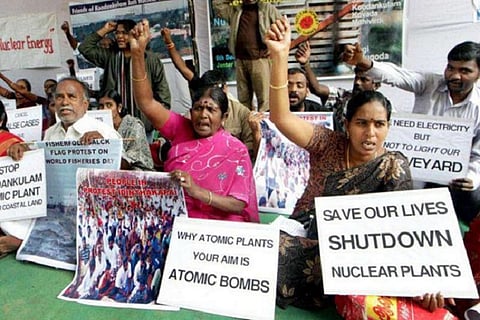

Andhra Pradesh has a coastline of 974 km. Keeping in mind the recent developments, in terms of nuclear power generation capacity, AP will, most likely, be producing 30,000 MW of the 63,0000 MW targeted for 2031. Now strictly assuming each reactor has a capacity of 1000 MW, then there would be 30 such reactors to meet the potential capacity of 30,000 MW. That’s a reactor for every 32 kms of the coastline, however the locations could be lesser, but impact significantly higher, if some reactors were clubbed together at a single spot.
And these reactors cannot be located in areas with a high population density. Therefore, at least three districts — East and West Godavari and Krishna — cannot be chosen, which would further decrease the inter-reactor density. And anyone with the slightest knowledge about Chernobyl or the more recent Fukushima, will quickly understand that these numbers are a cause for much concern.
Two of the nuclear power plants that are to be established in AP have actually been shifted from other locations in India due to strong opposition from the local farmers to part with their land. The first is the project, planned in Gujarat’s Mithi Virdi, by Toshiba Corp’s Westinghouse Electric to build six AP1000 reactors of 1,100 MW each. The second is in Haripur in West Bengal district which is a Russian project to build six Water-Water Energy reactors of 1000 MW capacity each. After CM Naidu’s visit to Russia, Kavali in Nellore district has been identified as the location for the Russian project.
Kovvada is located 70 km from Visakhapatnam in Ranasthalam mandal, Srikakulam district in Northern AP. With India’s biggest atomic power plant, six reactors each with a capacity of 1000 MW each, being established there it is set to become the focus for the anti-nuclear people’s movement. In fact, it could become the next Sompeta.
Sompeta agitation
Sompeta, a tranquil coastal town of North Srikakulam district in AP witnessed unprecedented violence on July 14, 2010, when locals tried to oppose acquisition of fertile multi-crop agricultural land by local authorities and armed police force for the construction, by Nagarjuna Construction Company Limited, of a Merchant Power Plant in that area.
This led to the death of three peasants and left hundreds of villagers, both men and women, severely wounded among whom 15 persons suffered severe bullet injuries. The contention of the villagers, environmentalists and human rights activists was that the power plant would generate more than 10,000 tons of ash daily, will pollute the local water bodies known as ‘beela’, and will eventually destroy the livelihoods of the villagers.
A well-planned and resilient struggle was carried out, led by the Paryavarana Parirakshana Samiti (PPS). A relay hunger strike was conducted for six-long years. And finally, the government bowed down to the power of grass-root democracy by cancelling the government order allocating the power plant to the area. This struggle is held as a shining example of successful people’s democratic movements, not just in AP but all over the country.
Is Kovvada next?
Well known environmental activist and former Union Power Secretary, Government of India, Mr. EAS Sharma, in a recent conversation, said, “The residents in and around Kovvada village, especially the fishing community in Srikakulam district, feel considerably apprehensive at the bleak prospect of losing their fertile agricultural lands and losing their access to the sea for fishing, in addition to being exposed to the potential dangers of a nuclear power project (6x1000 MW capacity) being set up by General Electric company.”
Moreover, he continued, "The six reactors at Kovvada will cost anywhere around Rs. 4-7 lakh crore and, without taking into account the cost of decommissioning the reactors at the end of the project life, the levelled unit cost of electricity is estimated to be around Rs 16-26 per kilo-ways-hour.”
CITU state president Ch. Narasinga Rao alleged that the administration is using various methods, like illegal distribution of money and forging land ownership documents, to pressurise the villagers to give up their land.
The PPS claimed that if the proposed land transfer for this project in Kovvada goes ahead, several coastal villages, close to 20,000 people, will be restricted to access nearby grazing grounds, fields and water bodies, which will result into chronic hunger and malnutrition. The landless peasants, living in Kovvada, Kotapalem, Tekkali and other villages will also lose employment as agricultural labourers when the government transfers the agricultural lands to the project. Also, there will be very limited employment opportunities for these unskilled village people in the proposed project.
Citing the examples of successful agitations in Sompeta, Kakarapalli, and Polaki in Srikakulam and other places PPS announced that with the help of workers from the Pydibhimavaram industrial zone and surrounding villagers they would stop the project at any cost.
Sharma further warned, “The civil nuclear liability law enacted by the government in our case has placed a very low cap on the liability that could be passed on to the reactor suppliers but the latter are not prepared to bear even such a limited liability. Under pressure, it is likely that the Government of India will finally bow down to the wishes of the reactor suppliers and find ways to exempt them from the liability, thereby creating scope for the latter to cut corners on the safety features of the reactors”.
The Environmental Impact Assessment(EIA) is still yet to be conducted. The Social Impact Assessment (SIA) report, which is necessary before land acquisition begins, conducted in June, is yet to be released. The leaders of the successful Sompeta agitation said that they will oppose the project at any cost. And towards this end, they are planning an awareness programme from Kavali to Kovvada to mobilise people.
With all this, the mega plan to make AP the nuclear energy hub of the country is definitely not going to be a cakewalk.